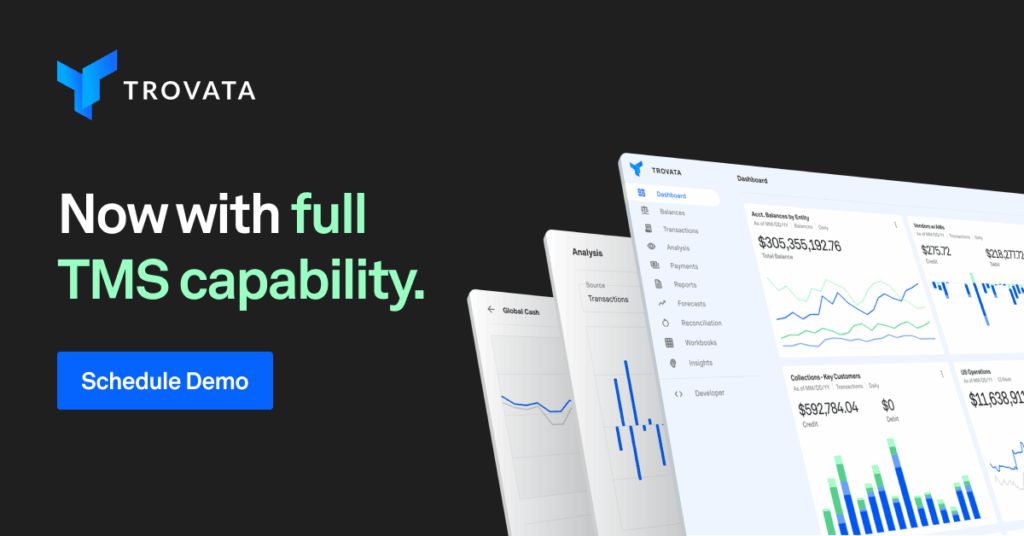Most treasury teams don’t rethink their bank relationships often. But when they do, whether prompted by growth, pricing concerns, or operational friction, it’s a unique opportunity to realign treasury operations around performance, cost, and strategic fit.
Because bank relationship reviews and RFPs aren’t just administrative exercises, they’re inflection points. It’s a chance to assess whether your banking partners are still delivering value, supporting your evolving needs, and enabling your treasury function.
It’s also a moment where inefficiencies become painfully visible. Disconnected systems. Manual reconciliations. Opaque fees. Poor service transparency. Many teams approach a bank review only to realize they don’t have the data they need to benchmark performance, or the infrastructure to take full advantage of a better deal.
In this article, we’ll explore how treasury teams can use a relationship review or RFP to not only optimize bank fees and services, but to modernize the way they connect and integrate with treasury ops.
Why Treasury Teams Revisit Bank Relationships
There are a few common catalysts for launching a formal review of your banking setup:
- Costs increases – Unexpected fees, outdated pricing models, or unnecessary services driving up total cost.
- Service issues – Poor response times, limited support for international operations, or outdated platforms that don’t meet your workflow needs.
- Increased complexity – As businesses scale across regions and entities, the old banking footprint may no longer be fit for purpose.
- Technology gaps – Banks that can’t support API-based connectivity, real-time data access, or digital tools for treasury teams.
- M&A activity – Legacy bank relationships from acquired entities need to be consolidated or rationalized.
- Leadership changes – A new CFO or treasurer may want to review all financial partners as part of a broader strategic refresh.
Regardless of the trigger, the objective is usually the same. Streamline cash operations, reduce friction, and ensure your banking partners are working for you.
Why a Treasury Platform Belongs in the Conversation
RFPs often focus heavily on pricing, coverage, and service levels. But an overlooked component is how a bank integrates with your internal treasury operations. And that’s where a next-generation treasury platform like Trovata can be a force multiplier.
Build Your Banking Review Around Your Existing Technology
If you’ve already got modern treasury technology in place, this should be a key driver of your decision-making in assessing new banking relationships. Before you finalize new agreements or change providers altogether, it’s worth asking:
- Can this bank support real-time API integrations with our treasury platform?
- How easily can we onboard new accounts or entities within our current infrastructure?
- Does this bank provide the transaction-level detail and remittance data needed to support our tagging and reporting framework?
- If we grow or restructure, can this bank scale with us, and can our platform manage that change with minimal disruption?
- What service or SLA guarantees exist for data access, uptime, or support, and how do those fit into our existing treasury workflows?
- Can we track and benchmark this bank’s fees and relationship performance directly within our treasury platform?
Your data quality and timeliness are your competitive edge, so you need banking partners—and technology—that support that.
Overhaul Your Treasury Function Before You Overhaul Your Banking
And if you don’t already have an integrated modern treasury technology platform in place? Now is the time to consider it. An overhaul of your banking relationships is the perfect time to align your operational requirements with your banking setup.
What you really want to avoid is looking only at your banking relationships now, then finding yourself implementing a new treasury platform 18 months later. This often leads to a fragmented or problematic integration process—or even the need to revisit your bank relationships all over again.
If you’re looking for a treasury platform that integrates seamlessly with your banking, questions you should ask include:
- Can we clearly measure how each banking partner is performing?
- How do we benchmark services like liquidity, transaction processing, and support?
- Do we have a central view of fees, balances, and usage across institutions?
- How hard is it to switch or add a new bank if needed?
Most organizations struggle to answer these questions quickly because their data is fragmented. That’s why bringing treasury technology into the review process can help you make more informed decisions, negotiate better terms, and build a more flexible cash infrastructure.
Reviewing both banking and technology at once allows you to ensure the entire department is aligned and starting with a clean slate.
“While other companies might say that bank connectivity is their thing, we’ve had such an easier time doing that with Trovata. They got all our accounts—including challenging ones like Mizuho in Japan—fully connected. When there were delays, they were always on the banks’ side, not Trovata’s…”
—Megan McLaughlan, Treasury Manager, Park Place Technologies
Read the full story
A Playbook for Getting More Value From Your Banking Relationships
1. Get a Real-Time View of Your Full Banking Footprint
Start with visibility, because you can’t optimize what you can’t see. Instead of relying on static reports or scattered Excel files, use API-based bank connectivity to bring all of your balances, transactions, and fee summaries into a single system.
2. Automate Tagging to Analyze Costs and Services
Organize your data in ways that help drive decisions. Tags let you break down cash movements and services by bank, business unit, service type, or cost center—giving you a powerful lens to identify overused, underutilized, or overpriced services.
3. Use Forecasting to Model Scenarios Across Banks
Modern forecasting tools let you test the impact of shifting transaction volume, changing funding cycles, or consolidating accounts—so you can see the real liquidity impact of banking decisions before you make them.
4. Streamline Bank Integrations with API-Readiness
Ease of integration should be a key consideration during any RFP. With a bank-agnostic treasury platform like Trovata, you can connect to new institutions quickly and maintain continuity in how you view and manage cash.
5. Manage Bank Relationships with Data-Driven Insights
Go beyond visibility into active relationship management. Trovata’s TMS capabilities centralize bank fees, benchmark service levels, and monitor counterparties against performance expectations. This turns the RFP into a true partnership evaluation, not just a cost comparison.
6. Build a Banking Strategy, Not Just a Vendor List
Ultimately, bank relationships should serve your broader strategy, not the other way around. With Trovata’s combined visibility, forecasting, and bank relationship management features, you can segment your banking footprint based on:
- Strategic importance
- Cost efficiency
- Operational flexibility
- Geographic coverage
- Product or service specialization
This intentional, data-driven approach ensures you’re not just renewing contracts, but actively optimizing your financial partnerships to align with business goals.
“With Trovata, the data is normalized and we now have a single source of truth where we can see everything we need to see. We are no longer manually logging into multiple portals and then spending hours aggregating that information. Trovata saves us so much time and enables us to focus on analysis and adding value.”
— Mary Desmond Director of Financial Operations at Sealaska Corporation
Read the full story
Make Your Next RFP a Strategic Win
A bank relationship review isn’t just about savings. It’s about building a treasury function that’s responsive, data-driven, and equipped for growth.
By using modern treasury tools like Trovata’s next-gen TMS, you gain the visibility, flexibility, and intelligence to turn a standard review into a strategic milestone.
Want to benchmark your bank performance, analyze fees, and modernize treasury operations? Book a demo to see how Trovata’s next-gen TMS combines real-time visibility, forecasting, and bank relationship management in one platform.




